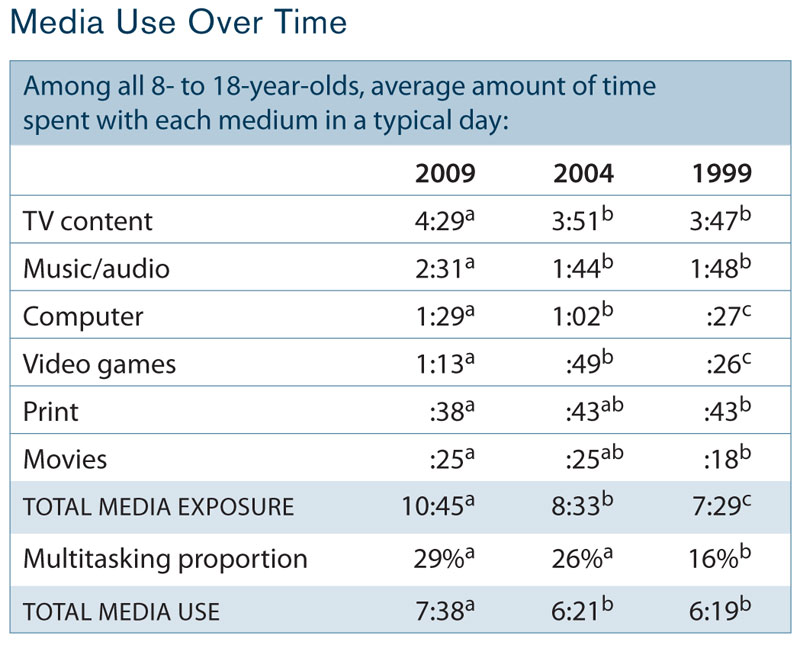Face it. We’re saturated with media.
Yesterday when I got up, the first sound I heard was the music oozing
from my girls’ iPods through their docking stations. Moments later, as
my 15-year-old daughter, Alyssa, came downstairs to breakfast, she was
texting a friend about homework. Meanwhile, my 13-year-old, Ashley,
quickly jumped online to check the weather. Five minutes later, we were
in the car and Ashley routinely plugged her iPod into the car’s system
so we could all benefit from hearing her music on the way to school.
I’ve read all the reports about media saturation. Our family doesn’t
leave the TV on, my kids don’t have Internet connections in their room,
and I’m very proactive about monitoring our home’s level of media
saturation. But the fact remains, it was only 7:32 a.m.…
and we were already soaked.
Just how media saturated is the average home in America?
Getting to the Truth
Nielson, Kaiser Foundation, Pew Internet, The American Academy of
Pediatrics…they’re all doing research about media saturation and the
effect of media in the lives of young people. Lucky for us, they all
seem to basically agree with their conclusions. But the funny thing I’ve
noticed is how newspapers, magazines and TV reports filter the data.
After all, the news has to be interesting…
even shocking, right?
Here’s how it usually works. One of these groups of experts will
release a study followed by a press release. Journalists read the
studies and write their opinions, quoting the numbers that leap off the
page. The common folk begin reading these articles and listening to the
findings on the
Today Show as they get ready for work. Pastor
Jones stands up on Sunday morning quoting the most shocking of those
numbers, and at lunch that afternoon, a group of elderly ladies in a
booth at the local diner say, “Did you hear that 98 percent of teenage
girls are prostitutes and drink a gallon of alcohol per hour?”
So don’t pay any attention to those email “forwards” and don’t believe the gossip. Check your sources (I
wrote about this in detail before).
That’s why you will always see us link our sources, so you can 1.) know
the validity of what you’re reading, and 2.) take a look at the
research with your own eyes.
Here’s some of the latest research on media in the lives of young people.
How Saturated Are We?
This month, Pew Internets’ researcher Amanda Lenhart released a helpful little presentation about the
Impact of Technology on the Lives of American Teens.
(I told you we linked our sources!) In this little slideshow, Lenhart
tries to cut through the hype and get straight to the facts about
exactly how media saturated Americans are.
Here are some of the specifics you might find noteworthy from her
study—a great summary about how plugged in teenagers are today:
• 93 percent of teenagers 12-17 are online—the largest percentage of any age group.
• Only 8 percent of families with teens have no computer, and only 4
percent of homes with computers don’t have access to Internet.
• 80 percent of teens 12-17 own a game console.
• 75 percent of all teens have a cell phone.
• A typical teen sends about 50 texts per day.
• Most teen cell phone users make 1-5 calls per day.
• 31 percent of teens who take their phones to school send text messages every day during class time.
• 73 percent of teens are on social Internet sites (like Facebook).
• Only 8 percent of teens use Twitter (compared to 37 percent of 18- to 24-year-olds—the largest percentage of any age group).
• 14 percent of teens now blog, compared to 28 percent in 2006.
• I encourage you to check out
Amanda Lenhart’s slideshow
on the subject. It’s ready-made for you, a great tool you can use to
educate parents or leaders about media saturated teenagers today. Amanda
is sharp, a trustworthy researcher (some of you might remember when
I talked with her in December of 2009 regarding her study about sexting among minors).
As thorough as Amanda’s report was, it didn’t deal with the amount of
time kids are actually simmering in front of the TV, the computer or
listening to music. There are several good sources to find this data,
the most thorough being the 2010 entertainment media consumption report
from Kaiser. We
already wrote quite a bit
about this report when it was released, but here is a chart revealing
exactly how many hours per day students are absorbing entertainment
media in recent years, compared to the past:

According to this sobering report, kids are now soaking in 10 hours
and 45 minutes per day of media in a mere 7 hours and 38 minutes. (This
requires multitasking. In other words, they are listening to iTunes
while browsing the web, all while the TV is on in the background.) You
probably noticed that this is an increase of over two hours of daily
entertainment media saturation since 2004.
Whenever I show this chart at my
parenting workshops,
parents are always surprised that kids spend more time watching TV than
they do browsing the Internet. But the numbers don’t lie (I’ve
blogged about this before), TV still rules the media war. For now,
American Idol, Glee and
Jersey Shore are still snaring more time from teenagers than Facebook is.
Our Response
So how do we respond to this kind of media saturation?
As parents, we should take the advice from the experts. The American
Academy of Pediatrics released a report in August of 2010 titled
Sexuality, Contraception and the Media. The doctors in this report shared some pretty shocking facts about the effects of media on young people. Here’s just a glimpse:
• More than 75 percent of prime-time programs contain sexual content.
• Only 14 percent of these incidents mention any risks or responsibilities of sexual activity.
• Talk about sex on TV can occur as often as 8 to 10 times per hour.
• Between 1997 and 2001 alone, the amount of sexual content on TV nearly doubled.
• Listening to sexually degrading lyrics is associated with earlier sexual intercourse.
• Out of nine longitudinal studies seeking to answer whether sexy
media contributes to early sexual activity, seven of these studies have
shown that exposure to sexual content in TV and other media in early
adolescence can as much as double the risk of early sexual intercourse.
• Early exposure to sexual content doubled the risk of teen pregnancy.
• Bedroom TVs are associated with greater substance use and sexual activity by teenagers.
• Research is clear that parents need to take an active role in
talking with their kids about media guidelines, and setting up realistic
media guidelines. This report actually offers some great advice to
parents, including limiting screen time, prohibiting media in bedrooms
and “co-viewing” media with kids. (Jonathan discusses these guidelines
and what they might look like in his book
Candid Confessions of an Imperfect Parent.)
Where do you draw the line?
Do your kids have a TV in their bedrooms? Do you know what’s on their iPods? Like I said earlier this week in
my blog about the connection between listening to pop music and depression, “The iPod is the window to the heart.”
On the proactive side: Have you made an effort to “co-view”
programming with your kids? Have you tried using media as conversation
jump-starters? Check out some of the resources we provide on our webpage
to help you dialogue with young people about media. Parents, you can
use our
MOVIE REVIEWS & QUICK Q’s page
to co-view films with your teenagers and then ask them questions at the
end of the film. We provide you with our two cents about the film and
some discussion questions to provoke conversation. Also consider using
our
MUSIC DISCUSSIONS page, using current songs to talk with your teenagers about important issues.
Youth workers, we provide the same resources, customized for a youth ministry setting on our youth ministry page
www.TheSource4YM.com. Just use the FREE RESOURCES & IDEAS dropdown menu on the top left hand side of the page.
However you choose to do it, become familiar with the media your kids
are immersed in daily. Talk with them about the content they are
absorbing, and don’t be afraid to set media guidelines. Saying no—while
not always popular—is usually pretty healthy. Too often, the parents at
our parenting seminars are on the brink of throwing in the towel. Don’t
do that; there are lots of tools at your disposal to help you help your
teens make wholesome media choices.
We can’t give up because the only thing beyond “media saturation” is “media drowning.”















 Volunteers Still Needed for January
Volunteers Still Needed for January




